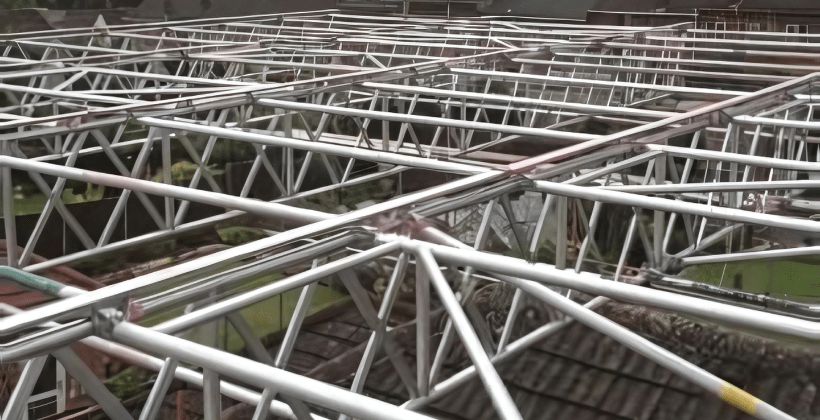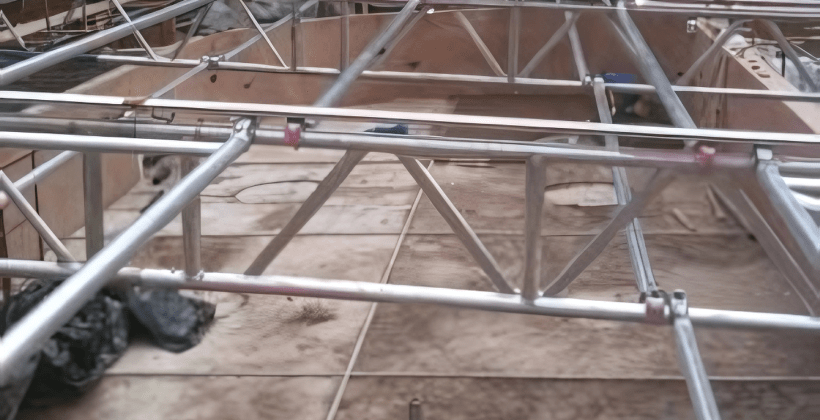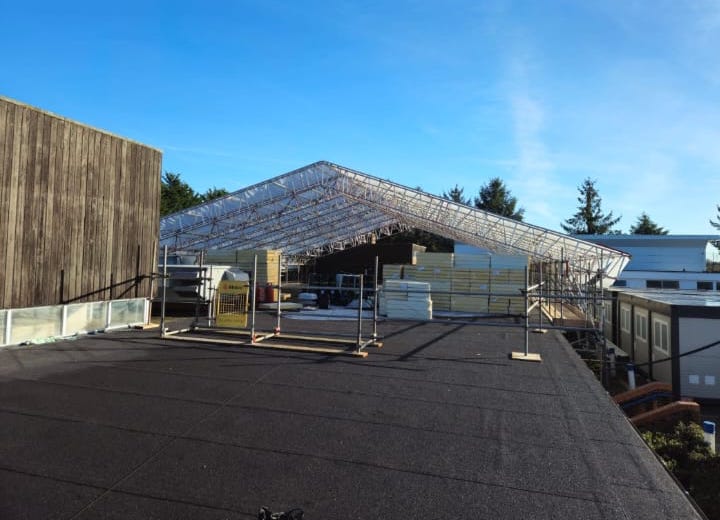Temporary roof scaffolding is one of the most effective ways to protect a construction or renovation project from delays caused by weather. Whether you’re a homeowner undergoing a loft conversion or a site manager overseeing a commercial build, unpredictable British weather can be a major obstacle. That’s where temporary roofing systems come in.
At Blaize Scaffolding, we offer professional temporary roof scaffolding across Birmingham and the West Midlands. In this blog, we’ll explain what temporary roof scaffolding is, how it works, when you need it, and why it’s a smart investment for protecting your project timeline, your budget, and your workforce.
What is Temporary Roof Scaffolding?
Temporary roof scaffolding is a weatherproof structure installed above a building or site to provide protection from the elements. It consists of a scaffold frame covered with sheeting, typically made of shrink wrap, corrugated plastic, or tin. These roofs can be fixed or retractable and are commonly used in both residential and commercial projects.
These systems are not just a canopy—they’re engineered to withstand wind, rain, and even snow. A professionally designed temporary roof can allow works to continue uninterrupted, helping avoid project extensions and unforeseen costs.
When Should You Use a Temporary Roof?
During Loft Conversions and Roof Replacements
If you’re planning a loft conversion, chimney repair, or complete roof replacement, your building will be exposed to the weather for several days or weeks. Temporary roof scaffolding ensures that the interior remains dry and secure.
For Listed and Heritage Properties
Buildings of historical or architectural significance need extra protection. Temporary roofs help preserve the structure during sensitive repair work and prevent water damage to irreplaceable features.
On Commercial or Public Sector Sites
Commercial roofing, school refurbishments, or office renovations all benefit from weather protection. Downtime on these projects can be expensive, especially with tight public-sector deadlines or lease agreements.
Throughout Winter or Wet Seasons
In Birmingham and the West Midlands, rain can fall at any time of year. But winter, in particular, brings high winds and damp conditions. Installing a temporary roof system allows your site to continue operating safely and efficiently.
Benefits of Temporary Roofing Systems
Protection from Delays
Rain can halt work, damage materials, and affect safety. With a robust temporary roof in place, you reduce or eliminate the need to stop work due to adverse weather.
Safety for Workers and Property
A covered site means fewer slips, better footing, and safer conditions overall. It also keeps tools, equipment, and interiors protected from water damage or mould.
Cost Control
Every day of delay adds costs to your project. Weather delays are often unpredictable and unbudgeted. A temporary roof can mitigate these risks and keep the build on schedule.
Professional Appearance and Compliance
For commercial clients, appearance matters. A clean, well-structured temporary roof helps your site look tidy and compliant with modern health and safety expectations.

Blaize Scaffolding’s Temporary Roof Services in Birmingham
At Blaize Scaffolding, we provide tailored temporary roof scaffolding systems throughout Birmingham, Solihull, and the wider West Midlands. Each structure is designed around your specific project, taking into account height, size, weather exposure, and access needs.
We supply:
- Shrink-wrapped or tin sheet roofing systems
- Static and rolling (retractable) designs
- Fully enclosed scaffold structures for additional containment
- Fast, safe erection by qualified scaffolders
We’ve worked on:
- Domestic roof refurbishments in Harborne and Edgbaston
- School roofing projects in Birmingham and Solihull
- Retail unit refurbishments in Birmingham city centre
We’re also fully insured and committed to safe scaffolding practices on every job.

FAQs – Temporary Roof Scaffolding
Is a temporary roof expensive?
The cost depends on the size, type of roof, and duration of hire. However, when compared to the cost of delays or weather-related damage, it’s often a cost-saving measure.
How long does it take to install?
Most temporary roofs are installed in 1–3 days, depending on size and complexity. We’ll provide a clear timeline during our quotation process.
Can a temporary roof withstand high winds?
Yes. Our systems are built to industry safety standards and are designed to resist wind uplift and weather exposure. We also inspect and maintain them throughout the hire period.
Do I need planning permission?
In most cases, no. Temporary roof scaffolding is typically considered a permitted development, but if you’re working on a listed building or in a conservation area, it’s best to check with your local council.
Will it affect light inside the property?
We use translucent materials that allow natural light to enter while still providing full rain protection.
Final Thoughts: Is Temporary Roof Scaffolding Worth It?
Temporary roof scaffolding is an investment that offers major returns in project reliability, safety, and peace of mind. Especially in areas like Birmingham where the weather is unpredictable, protecting your site from delays and water ingress can save both time and money.
At Blaize Scaffolding, we bring experience, professionalism, and attention to detail to every temporary roof installation. Whether you’re working on a family home or a major public sector refurbishment, we’ll design and install a system that keeps your project protected and on schedule.
To discuss your needs and learn more about our services, call Blaize Scaffolding at 0121 270 7868 or 07979 597 979.

